Different types of hearing aids
There are many different types of hearing aid, however, the styles remain similar across all of the different manufacturers. Some hearing aid manufacturers may use different names but the overall concept is similar. The different types have different levels of suitability for Patients. Suitability can be limited by the level of hearing loss, the size and shape of canal or the conditions of the canal. Suitability can also be limited by the dexterity and vision of a Patient. Small devices are not necessarily suitable for people with dexterity or sight problems. If you can't manage the devices you can't use them.
Types of Hearing Aid
Invisible In Canal (IIC) Hearing Aids
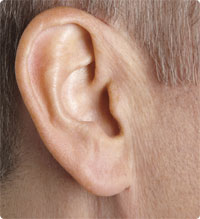 IICs are extremely small, custom made hearing aids designed to fit completely deep in your ear canal. Cosmetically they are invisible and they are usually only suitable for mild to moderate hearing losses.
IICs are extremely small, custom made hearing aids designed to fit completely deep in your ear canal. Cosmetically they are invisible and they are usually only suitable for mild to moderate hearing losses.
These are the one of the types of hearing aids that can be difficult to handle if dexterity or vision is an issue. Contra indications to their use would also be moist ears, ears prone to infection or ears prone to the over production of wax. All of these problems will cause malfunction of the hearing aid. Size and shape of ear canal is also an issue with IICs.
Completely In Canal (CIC) Hearing Aids
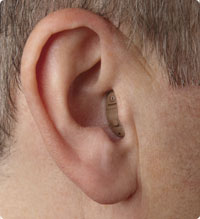
Very small, custom-made hearing aids that are designed to fit completely in your ear canal. They are not as small as the invisible type. Cosmetically they are very good, they can be seen but just barely. They are normally suitable for mild to moderate hearing losses. As with the IIC they can be difficult to handle if dexterity or vision is an issue.
Contra indications to their use are the same as with IICs.
In the Canal (ITC) Hearing Aids
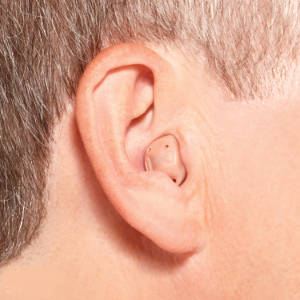 Slightly bigger custom made hearing aids than the CIC. Traditionally hearing aid manufacturers have used ITCs to deliver slightly more power, due to the bigger size, it allows for more output. They are often suitable for mild to moderately severe hearing loss.
Slightly bigger custom made hearing aids than the CIC. Traditionally hearing aid manufacturers have used ITCs to deliver slightly more power, due to the bigger size, it allows for more output. They are often suitable for mild to moderately severe hearing loss.
They generally tend to have a bigger battery, which means longer battery life. Some may also have directional microphones. As with the IIC and CIC they can be difficult to handle if dexterity or vision is an issue even though they are bigger. Contra indications to their use are the same as with the other custom hearing aids.
In the Ear Half Shell (ITE-HS) Hearing Aids
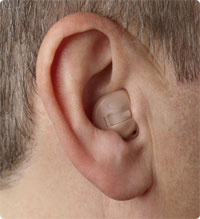
Slightly larger custom made hearing aids than the ITC, and much easier to handle. Because of the larger size, it is possible to have more features added to the hearing aid such as directional microphones, a programme button and even a volume control depending on the manufacturer.
Cosmetically they are discreet but visible, in fact an RIC device which we will discuss later is probably less visible even though it is classed as a behind the ear device. Although dexterity issues are not as common place with half shell aids, it is still something that needs to be considered if dexterity or vision is an issue for a Patient. Contra indications to their use are the same as with all of the custom aids.
In the Ear Full-shell (ITE-FS) Hearing Aids
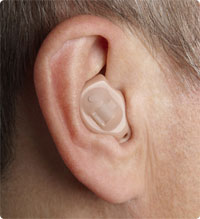 The biggest of the custom-made hearing aids. They nearly always use a bigger battery, which means longer battery life. They are suitable for mild to severe hearing losses. Due to its size, it is possible to have manual features such as volume control, programme button etc added to it. Most Full Shell hearing aids would be dual microphone aids.
The biggest of the custom-made hearing aids. They nearly always use a bigger battery, which means longer battery life. They are suitable for mild to severe hearing losses. Due to its size, it is possible to have manual features such as volume control, programme button etc added to it. Most Full Shell hearing aids would be dual microphone aids.
Cosmetically they aren't very discreet, RIC devices which we will discuss later are certainly less visible. Dexterity is not usually an issue with aids of this type. Contra indications to their use are the same as with all of the custom aids.
Behind the Ear (BTE) Hearing Aids
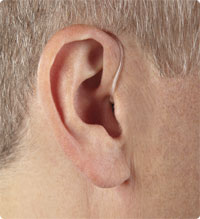 The most versatile of all hearing aids, they can suitable for mild to profound hearing losses. Bigger batteries, which means longer battery life. Due to its size, it is easier to handle and can have many physical features added to it. They are more reliable normally than custom aids, because the most important parts are kept well away from the hostile environment of the ear canal.
The most versatile of all hearing aids, they can suitable for mild to profound hearing losses. Bigger batteries, which means longer battery life. Due to its size, it is easier to handle and can have many physical features added to it. They are more reliable normally than custom aids, because the most important parts are kept well away from the hostile environment of the ear canal.
Depending on the type of aid and the connection to the ear that is used they can actually be very discrete. Many BTEs can be fitted with a thin tube and dome for both open fit and closed fit type of losses, this makes them very discrete options. There are no real contra-indications to using a BTE apart from if you don't have an outer ear.
Receiver in the Canal (RIC) Hearing Aids
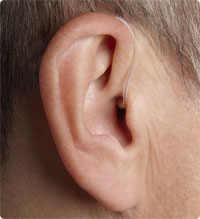 A more recent addition to hearing aid types, sometimes called Receiver In The Ear (RITEs), the are very small and discrete because the speaker part of the aid (the receiver) is removed from the hearing aid body. It looks like a very small BTE hearing aid, however, the speaker part is placed in the Patient's ear canal. This improves the sound quality and allows the hearing aid to be fitted on hearing losses that stretch from mild to profound.
A more recent addition to hearing aid types, sometimes called Receiver In The Ear (RITEs), the are very small and discrete because the speaker part of the aid (the receiver) is removed from the hearing aid body. It looks like a very small BTE hearing aid, however, the speaker part is placed in the Patient's ear canal. This improves the sound quality and allows the hearing aid to be fitted on hearing losses that stretch from mild to profound.
Significantly, they are smaller and cosmetically more appealing to younger Patients. Covers mild to severe hearing losses. Although dexterity issues are not as common place with this type of hearing aid, it is still something that needs to be considered if dexterity or vision is an issue for a Patient. Contra indications to their use are similar to those of custom aids. This is because of the placement of the receiver in the ear canal
So if you are interested in hearing aids or a hearing test in Guernsey, why don't you call us on 01 481 245999 for an appointment or book your appointment online below.

